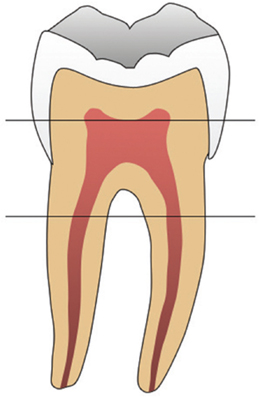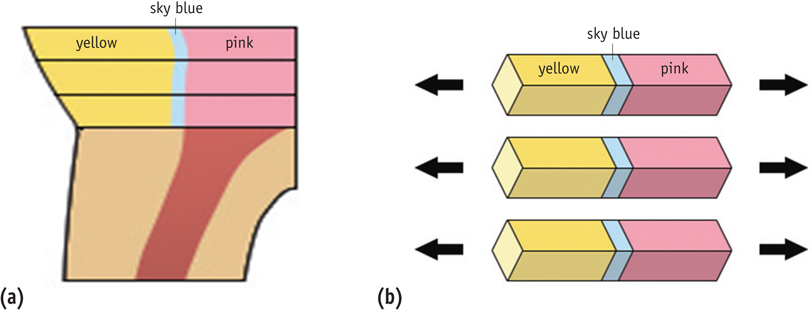Restor Dent Endod.
2012 Nov;37(4):207-214.
Effect of chlorhexidine application on the bond strength of resin core to axial dentin in endodontic cavity
- Affiliations
-
- 1Department of Conservative Dentistry, Dankook University College of Dentistry and Institute of Dental Science, Cheonan, Korea. donyshin@dankook.ac.kr
Abstract
OBJECTIVES
This study evaluated the influence of chlorhexidine (CHX) on the microtensile bonds strength (microTBS) of resin core with two adhesive systems to dentin in endodontic cavities.
MATERIALS AND METHODS
Flat dentinal surfaces in 40 molar endodontic cavities were treated with self-etch adhesive system, Contax (DMG) and total-etch adhesive system, Adper Single Bond 2 (3M ESPE) after the following surface treatments: (1) Priming only (Contax), (2) CHX for 15 sec + rinsing + priming (Contax), (3) Etching with priming (Adper Single Bond 2), (4) Etching + CHX for 15 sec + rinsing + priming (Adper Single Bond 2). Resin composite build-ups were made with LuxaCore (DMG) using a bulk method and polymerized for 40 sec. For each condition, half of specimens were submitted to microTBS after 24 hr storage and half of them were submitted to thermocycling of 10,000 cycles between 5degrees C and 55degrees C before testing. The data were analyzed using ANOVA and independent t-test at a significance level of 95%.
RESULTS
CHX pre-treatment did not affect the bond strength of specimens tested at the immediate testing period, regardless of dentin surface treatments. However, after 10,000 thermocycling, all groups showed reduced bond strength. The amount of reduction was greater in groups without CHX treatments than groups with CHX treatment. These characteristics were the same in both self-etch adhesive system and total-etch adhesive system.
CONCLUSIONS
2% CHX application for 15 sec proved to alleviate the decrease of bond strength of dentin bonding systems. No significant difference was shown in microTBS between total-etching system and self-etching system.
Keyword
MeSH Terms
Figure
Reference
-
1. Swanson K, Madison S. An evaluation of coronal microleakage in endodontically treated teeth. Part I. Time periods. J Endod. 1987. 13:56–59.
Article2. Kijsamanmith K, Timpawat S, Harnirattisai C, Messer HH. Micro-tensile bond strengths of bonding agents to pulpal floor dentine. Int Endod J. 2002. 35:833–839.
Article3. Weine FS. Nonsurgical re-treatment of endodontic failures. Compend Contin Educ Dent. 1995. 16:324326–335. quiz 335.4. Eakle WS. Fracture resistance of teeth restored with class II bonded composite resin. J Dent Res. 1986. 65:149–153.
Article5. Nakabayashi N, Kojima K, Masuhara E. The promotion of adhesion by the infiltration of monomers into tooth substrates. J Biomed Mater Res. 1982. 16:265–273.
Article6. Pashley DH, Tay FR, Yiu C, Hashimoto M, Breschi L, Carvalho RM, Ito S. Collagen degradation by host-derived enzymes during aging. J Dent Res. 2004. 83:216–221.
Article7. Tjäderhane L, Larjava H, Sorsa T, Uitto VJ, Larmas M, Salo T. The activation and function of host matrix metalloproteinases in dentin matrix breakdown in caries lesions. J Dent Res. 1998. 77:1622–1629.
Article8. Sulkala M, Wahlgren J, Larmas M, Sorsa T, Teronen O, Salo T, Tjäderhane L. The effects of MMP inhibitors on human salivary MMP activity and caries progression in rats. J Dent Res. 2001. 80:1545–1549.
Article9. Martin-De Las Herasa S, Valenzuela A, Overall CM. The matrix metalloproteinase gelatinase A in human dentine. Arch Oral Biol. 2000. 45:757–765.
Article10. Bok YB, Lee DY, Lee CY, Kim KN, Kum KY. The sustaining effect of three polymers on the release of chlorhexidine from a controlled release drug device for root canal disinfection. J Korean Acad Conserv Dent. 2004. 29:548–554.
Article11. Gendron R, Grenier D, Sorsa T, Mayrand D. Inhibition of the activities of matrix metalloproteinases 2, 8, and 9 by chlorhexidine. Clin Diagn Lab Immunol. 1999. 6:437–439.
Article12. Hebling J, Pashley DH, Tjäderhane L, Tay FR. Chlorhexidine arrests subclinical degradation of dentin hybrid layers in vivo. J Dent Res. 2005. 84:741–746.
Article13. Kanca J 3rd. Improving bond strength through acid etching of dentin and bonding to wet dentin surfaces. J Am Dent Assoc. 1992. 123:35–43.
Article14. Kaaden C, Powers JM, Friedl KH, Schmalz G. Bond strength of self-etching adhesives to dental hard tissues. Clin Oral Investig. 2002. 6:155–160.
Article15. Suzuki T, Finger WJ. Dental adhesives: site of dentin vs. bonding of composite resins. Dent Mater. 1988. 4:379–383.16. Pashley EL, Tao L, Matthews WG, Pashley DH. Bond strengths to superficial intermediate and deep dentin in vivo with four dentin bonding systems. Dent Mater. 1993. 9:19–22.
Article17. Yoshiyama M, Carvalho R, Sano H, Horner J, Brewer PD, Pashley DH. Interfacial morphology and strength of bonds made to superficial versus deep dentin. Am J Dent. 1995. 8:297–302.18. Giannini M, Carvalho RM, Martins LR, Dias CT, Pashley DH. The influence of tubule density and area of solid dentin on bond strength of two adhesive systems to dentin. J Adhes Dent. 2001. 3:315–324.19. Nikaido T, Takano Y, Sasafuchi Y, Burrow MF, Tagami J. Bond strengths to endodontically-treated teeth. Am J Dent. 1999. 12:177–180.20. Farina AP, Cecchin D, Barbizam JV, Carlini-Júnior B. Influence of endodontic irrigants on bond strength of a self-etching adhesive. Aust Endod J. 2011. 37:26–30.
Article21. Hommez GM, Coppens CR, De Moor RJ. Periapical health related to the quality of coronal restorations and root fillings. Int Endod J. 2002. 35:680–689.
Article22. Tay FR, Pashley DH, Loushine RJ, Weller RN, Monticelli F, Osorio R. Self-etching adhesives increase collagenolytic activity in radicular dentin. J Endod. 2006. 32:862–868.
Article23. Carrilho MR, Geraldeli S, Tay F, de Goes MF, Carvalho RM, Tjäderhane L, Reis AF, Hebling J, Mazzoni A, Breschi L, Pashley D. In vivo preservation of the hybrid layer by chlorhexidine. J Dent Res. 2007. 86:529–533.
Article24. Erdemir A, Ari H, Güngüneş H, Belli S. Effect of medications for root canal treatment on bonding to root canal dentin. J Endod. 2004. 30:113–116.
Article25. Campos EA, Correr GM, Leonardi DP, Barato-Filho F, Gonzaga CC, Zielak JC. Chlorhexidine diminishes the loss of bond strength over time under simulated pulpal pressure and thermo-mechanical stressing. J Dent. 2009. 37:108–114.
Article26. Rosenthal S, Spångberg L, Safavi K. Chlorhexidine substantivity in root canal dentin. Oral Surg Oral Med Oral Pathol Oral Radiol Endod. 2004. 98:488–492.
Article27. Loguercio AD, Stanislawczuk R, Polli LG, Costa JA, Michel MD, Reis A. Influence of chlorhexidine digluconate concentration and application time on resin-dentin bond strength durability. Eur J Oral Sci. 2009. 117:587–596.
Article28. Kanca J 3rd. Effect of resin primer solvents and surface wetness on resin composite bond strength to dentin. Am J Dent. 1992. 5:213–215.29. Frankenberger R, Perdigão J, Rosa BT, Lopes M. "No-bottle" vs "Multi-bottle" dentin adhesives-a microtensile bond strength and morphological study. Dent Mater. 2001. 17:373–380.
Article30. Mazzoni A, Pashley DH, Nishitani Y, Breschi L, Mannello F, Tjäderhane L, Toledano M, Pashley EL, Tay FR. Reactivation of inactivated endogenous proteolytic activities in phosphoric acid-etched dentine by etch-and-rinse adhesives. Biomaterials. 2006. 27:4470–4476.
Article31. Ozturk B, Ozer F. Effect of NaOCl on bond strengths of bonding agents to pulp chamber lateral walls. J Endod. 2004. 30:362–365.
Article32. Yuan Y, Shimada Y, Ichinose S, Tagami J. Effect of dentin depth on hybridization quality using different bonding tactics in vivo. J Dent. 2007. 35:664–672.
Article33. Butz F, Lennon AM, Heydecke G, Strub JR. Survival rate and fracture strength of endodontically treated maxillary incisors with moderate defects restored with different post-and-core systems: an in vitro study. Int J Prosthodont. 2001. 14:58–64.34. Kazemi RB, Meiers JC, Peppers K. Effect of caries disclosing agents on bond strengths of total-etch and self etching primer dentin bonding systems to resin composite. Oper Dent. 2002. 27:238–242.35. Spangberg L, Engström B, Langeland K. Biologic effects of dental materials. 3. Toxicity and antimicrobial effect of endodontic antiseptics in vitro. Oral Surg Oral Med Oral Pathol. 1973. 36:856–871.36. Santos JN, Carrilho MR, De Goes MF, Zaia AA, Gomes BP, Souza-Filho FJ, Ferraz CC. Effect of chemical irrigants on the bond strength of a self-etching adhesive to pulp chamber dentin. J Endod. 2006. 32:1088–1090.
Article37. Marshall GW Jr, Marshall SJ, Kinney JH, Balooch M. The dentin substrate: structure and properties related to bonding. J Dent. 1997. 25:441–458.
Article38. Levartovsky S, Goldstein GR, Georgescu M. Shear bond strength of several new core materials. J Prosthet Dent. 1996. 75:154–158.
Article
- Full Text Links
- Actions
-
Cited
- CITED
-
- Close
- Share
- Similar articles
-
- The effect of bonding resin on bond strength of dual-cure resin cements
- Effect of 2% chlorhexidine application on microtensile bond strength of resin composite to dentin using one-step self-etch adhesives
- Changes in micro-TBS to pulp chamber dentin after the application of NaOCl & reversal effect by using sodium ascorbate
- Bonding of a resin-modified glass ionomer cement to dentin using universal adhesives
- Effect of different chlorhexidine application times on microtensile bond strength to dentin in Class I cavities



